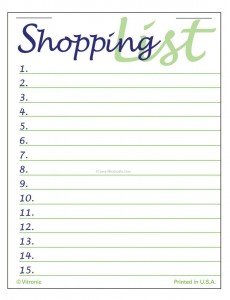Your cart is currently empty!
STEP SEVEN: YOUR SHOPPING LIST
If people have quite a few groceries to buy, they make a shopping list. Now, you don’t have “a few things” to do with your novel—you’re going to be filling hundreds of pages. You make a shopping list to make sure you have enough food and don’t forget anything. You make a spreadsheet of scenes for your novel to make sure you have enough material for a book-length work and so that you don’t forget anything.
For this step, you create a list of 80 to 100 scenes (not chapters, scenes—several scenes make up a chapter). This is a list of things that might happen, beginning to end, in your novel. Here’s a look at how I do it:
SCENE # VIEWPOINT CHARACTER DESCRIPTION SML
1 Blake Mack slams into cyclist l
2 Blake Mack fakes his own death m
3 News report car explosion reported s
4 Roxy Lee harassment at office s
The scene #s just help me keep track. Once I have between 80 and 100 scenes, I know I’ll have enough material for a book-length work.
The viewpoint character helps me track the amount of attention I’m giving each character. In this novel, Roxy and Blake SHOULD get the majority of the scenes; they’re my main characters. The list shows me if I have my scenes balanced in terms of the attention each character gets, but it also makes me aware of how long I’ve left a character before I come back to him or her.
The description is plot. This makes that happen which makes something else happen which leads to the end. In my mind, the accident in scene one leads to Blake faking his death and assuming his identity in scene two. The news report is of a high-speed chase that led to the death of small-time criminal, Blake Mack. Roxy Lee, the newest female officer at her detachment, will be dealing with this seemingly open and shut case, since no one really wants to handle the paperwork, and all of the other work seems straightforward and boring.
S, M, or L? Small, medium, or large? I used to attempt to guess the number of pages a scene might take, but that got frustrating and ate up a ton of mental power. Instead, I now think, Is this a big part of my novel (L), or a small one (S)? Neither? Then it’s in between (M). The reason for this? Pacing. Too many long scenes in a row, and the story begins to sag; too many short ones in a row and you have machine-gun fire that your reader will find hard to keep up with.
Try this:
This is basically a scroll of scenes that takes you from the beginning to the end of your book. It is not set in stone. If you get a better idea, go with it, but by having a plan for your entire book, you know where you have to get to at least and can feel free to take detours along the way in HOW you get there. Finish this step, and you’re ready to WRITE YOUR NOVEL!


Leave a Reply